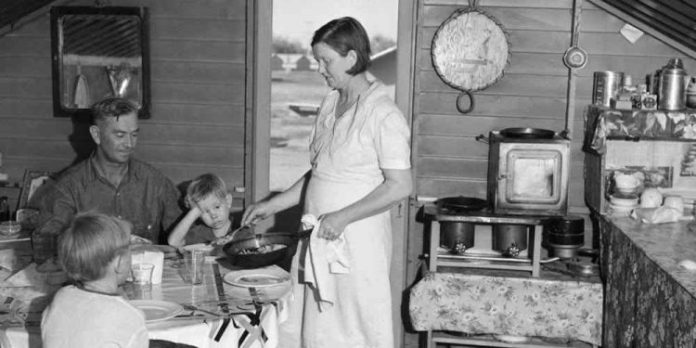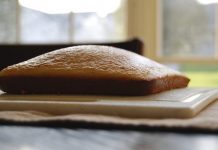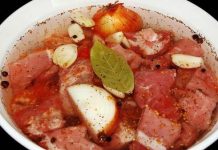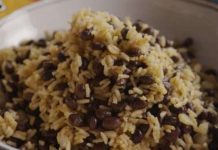World War Two was a total war, and the Allies had to mobilize their whole economies to produce the weapons and supplies needed to fight it. That restricted what was left for the civilian population, and rationing was introduced to make sure everyone got a fair share of scarce resources.
In the US, rationing was fairly mild; gasoline was rationed, and so were some “luxuries” like coffee and sugar, but most foods were still easily available.
However, in Britain, it was very different. Because the UK imports a lot of its food, and this was a lot more difficult when German submarines were sinking every ship they could, food was in short supply – and rationing was very strict.
For most of the war, a British adult was rationed to one egg a week. They could buy 8oz of bacon or ham, and around 20oz of other meat. Moreover, dairy products were severely restricted, with the weekly ration adding up to 2oz of cheese and 2oz of butter. Half a pound of sugar a week, 4oz of margarine, 4oz of lard… it isn’t much.
Luckily potatoes, vegetables and bread weren’t rationed, so people could bulk out their diet with those, but a plate of boiled potatoes and cabbage isn’t exactly the most exciting meal. To keep morale up through six long years of war, people had to get creative with their rations.
So, here are some of the recipes they came up with:
Lord Woolton Pie
Named after Lord Woolton, the wartime Minister of Food, this filling pie was created by the head chef at London’s Savoy Hotel in 1941. Its main ingredients are potatoes and other root vegetables – whatever was available.
Ingredients:
- 1 1/2 pound potatoes
- one lb. swede
- one lb. carrots
- 1 pound cauliflower, parsnips or rutabaga
- 4 spring onions
- 1 tablespoon oatmeal
- 1 vegetable bouillon cube
- Water
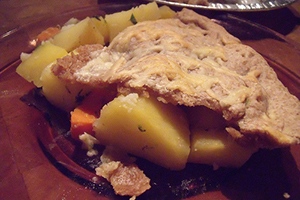

When the vegetable mixture is cooked, drain it (save the liquid) then allow to cool. Simmer the cooking liquid to reduce and thicken it. Peel, cook and mash the remaining potatoes; add some butter or lard if you have it.
When the diced vegetables have cooled put them in a greased pie dish and pour some of the thickened cooking liquid over the top to act as a sauce.
Sprinkle with chopped parsley (fresh or dried) if you have it. Spread the mashed potato over the top and bake in a moderate oven until the crust is browned.
Patriotic Pudding
Carrots had been a favorite vegetable in Britain since Roman times, but under rationing people found many new uses for them. Carrot cake became popular in the UK during WWII, and people adapted the same principle to replace traditional fruit puddings.
“Patriotic Pudding” was a steamed pudding with a vegetable touch.
Ingredients:
- ¼ cup flour
- ¼ cup grated raw potato or fine oatmeal
- 1 tablespoon margarine or butter
- 1 finely grated carrot
- ½ tablespoon jelly or molasses
- ½ teaspoon baking soda
- Pinch of salt
- 2 teaspoons grated citrus rind (optional)
- Milk (if available) and water to mix
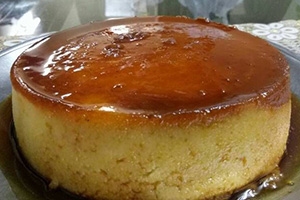

Rub the fat into the flour to make a crumbly mixture. Add the potato or oatmeal, baking soda and salt, and the citrus rind if you’re using it. Mix well.
Add the jelly and carrot, and four tablespoons of heated milk or water. After that, mix until smooth, put it in a well-greased bowl, cover with foil and steam for an hour.
Moreover, serve with custard if you have it, or a spoonful of jelly or maple syrup.
Wartime Potato Soup
You’re probably already getting the idea that potatoes were a big part of the rationing-era diet. Yes they were, and people were always looking for new ways to make them more interesting.
For instance, one option was this popular soup, which makes a great winter appetizer – or even a meal on its own.
Ingredients:
- 2 large potatoes
- 1 large onion
- 4 medium leeks
- 3 sticks celery
- one quart vegetable broth
- a tablespoon of oil
- 1 tbsp. chopped parsley (fresh or dried)
- 1 tbsp. fresh thyme leaves (optional)
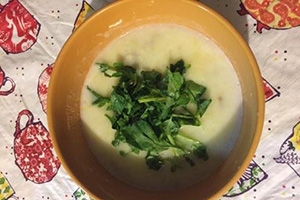

Secondly, add the potatoes and thyme (if you have it), and fry for another five minutes. Stir in the broth and bring to a low simmer.
Thirdly, cover and cook for around 30 minutes until the vegetables are soft. Blend until smooth, or puree by forcing it through a sieve with a wooden spoon. Add more hot broth if it’s too thick. Spoon into bowls, garnish with the chopped parsley and serve.
Cheese and Lentil Spread
The cheese ration was far from generous, and people tried everything they could to make it stretch further.
A popular recipe, first used in WWI and then brought back during WWII, used unrationed lentils, bread and onions to bulk up the cheese ration and make a tasty sandwich spread.
Ingredients:
- 2 ounces cheese
- 2 ounces red lentils
- 1 ounce breadcrumbs
- 1 ounce onions
- ½ ounce lard or butter
- Chopped parsley
- Salt and pepper
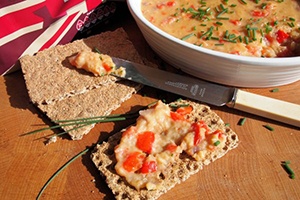

Firstly, grate the cheese and set aside in a bowl. Peel and finely chop the onion, wash the lentils and cook them with the onion in a little water, stirring occasionally.
When the lentils have nearly finished cooking add the mixture to the grated cheese, stir in the breadcrumbs and lard or butter, season well with salt, pepper and chopped parsley and mix it all together thoroughly.
Use as a sandwich filling or on toast.
Carrot Curry
Indian food has been popular in Britain for a long time, but with meat strictly rationed during the war it was hard to create favorite recipes.
Ingenious cooks soon realized they could use unrationed carrots as a substitute, though. This is a simple, filling and nutritious recipe that still manages to be tasty.
Ingredients:
- 1 pound carrots
- 1-ounce margarine or lard
- a large onion
- 2 teaspoons curry powder
- I tablespoon flour
- ½ pint broth
- 1 teaspoon sugar
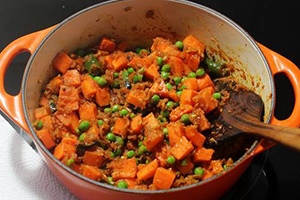

Chop the carrots and boil or steam them. While they’re cooking (don’t overdo them) melt the fat in a saucepan, chop the onion and fry until soft. Then, add the curry powder and flour and fry for another couple of minutes, stirring often. Stir in the broth and bring to the boil, then season well with salt and pepper.
Also, add the sugar and a teaspoon of vegetable extract if you have it. Simmer the sauce gently for about 20 minutes, then add the carrots and cook for another ten minutes. Serve with rice; for the authentic 1940s British curry taste, sprinkle some raisins and grated dried coconut on top.
Wartime Meat Gravy
What do you do when you love meat but can’t get enough of it? One option is to make a big batch of rich meat gravy and use it to add the right taste to vegetable-based dishes like Lord Woolton Pie.
A week’s meat ration, bought as ground beef, will make enough of this beefy sauce to flavour your carrots and potatoes all week.
Ingredients:
- 8 ounces ground beef
- 8 ounces over-ripe tomatoes (if you have them)
- a large onion
- 1 beef bouillon cube
- Salt and pepper
- Dried thyme if available
- Water
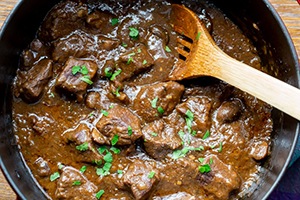

Then, season well with salt, pepper and thyme if you have it. Chop the tomatoes up small and add them to the gravy.
Simmer on a low heat for at least 20 minutes; thicken with cornstarch if needed. To serve, spoon some over potatoes (boiled or mashed) or Woolton Pie.
In conclusion, this is just a sample of wartime rationing recipes. There were many more – as many as there were ingenious cooks who wanted to eat well even with a restricted diet.
Here are some more examples:
- Vegetable turnovers: these vegetable-stuffed pastry crusts are big and filling. They’re also portable, making them an idea option for a wartime packed lunch.
- How do you make cake frosting when sugar is strictly rationed? You make it from mashed potato, of course!
- Dried fruit was still available during the war, but it could be in short supply. One way to make it go further was by baking a date and carrot tart.
- Carrots and potatoes for dinner again? Liven up the meal you’ve had every day since 1939 by turning it into a tasty French-style vegetable ragout.
- Make your tiny ration go further by enjoying a big plate of cheap and unrationed cauliflower, livened up with small amounts of bacon and cheese.
- Spam spam spam spam wonderful spam! But your ration points only let you buy a couple of cans a month. Enjoy Spam-loaded potato hash to make it go further.
Try some of these wartime recipes, and let us know what you think in the comments – and feel free to share any of your own!



